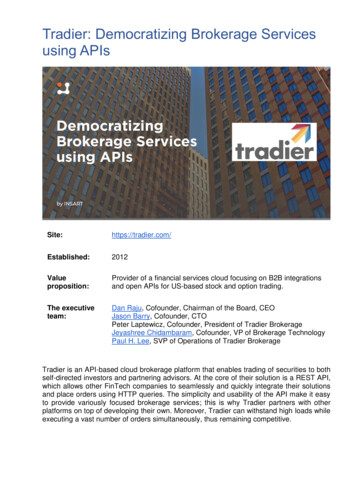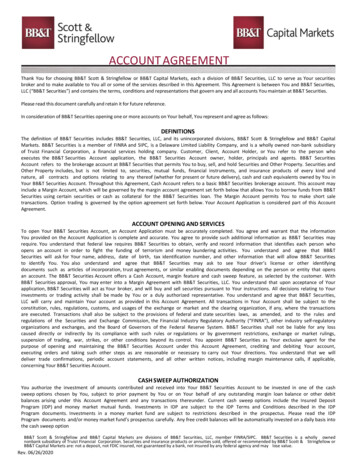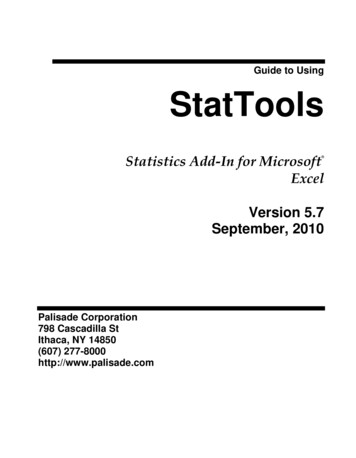
Transcription
Tradier: Democratizing Brokerage Servicesusing proposition:Provider of a financial services cloud focusing on B2B integrationsand open APIs for US-based stock and option trading.The executiveteam:Dan Raju, Cofounder, Chairman of the Board, CEOJason Barry, Cofounder, CTOPeter Laptewicz, Cofounder, President of Tradier BrokerageJeyashree Chidambaram, Cofounder, VP of Brokerage TechnologyPaul H. Lee, SVP of Operations of Tradier BrokerageTradier is an API-based cloud brokerage platform that enables trading of securities to bothself-directed investors and partnering advisors. At the core of their solution is a REST API,which allows other FinTech companies to seamlessly and quickly integrate their solutionsand place orders using HTTP queries. The simplicity and usability of the API make it easyto provide variously focused brokerage services; this is why Tradier partners with otherplatforms on top of developing their own. Moreover, Tradier can withstand high loads whileexecuting a vast number of orders simultaneously, thus remaining competitive.
To get more details first hand, I met with Jason Barry, CTO andCofounder. He takes on the technical side of the work due to hisdevelopment background. We discussed many technical aspects andI obtained an oversight of the role of API-based solutions for theindustry today.Like the other cofounders, Jason previously worked at TradeKing,which has been acquired by Ally. TradeKing delivered APIs whilemaking lots of internal services available.“We all recognized that we felt like there was a really good opportunity to take theseAPIs and build something really great that made a lot of these financial servicesavailable to anybody.”The history of Tradier starts in 2012. Within about a year, Jason and the other cofoundersraised about two million dollars to start the broker-dealer, register in 50 states, and build thetech. They assessed the real market need and grew their technology stack from zero to over300 million API calls per month, with hundreds of thousands of requests per hour at peaktimes.Renovating the API-based platform conceptJason recognizes that the idea of providing an API for brokerage services isn’t new. Thereare several companies that have been providing APIs for much longer, such as InteractiveBrokers. Nevertheless, their offerings don’t interfere with Tradier as there are manydifferentiators that ensure the company has its own customers.“[Compared to Interactive Brokers,] our pricing models are very different and targetvery different investors. We offer really transparent fees and our API technology isvastly different, much more modern, as with REST-based APIs one can pretty much[integrate] from anywhere, [using] any kind of language.”Unlike with Interactive Brokers, customers don’t need to set up servers, have them runningall the time, and still have software in place, as everything is done in the cloud. In this way,Tradier ensures the house processes are well documented, as changes made without noticecan greatly affect the partners’ businesses.
“We heard horror stories from other customers who have integrated with brokerswhere they wake up one morning and all their stuff is broken because a changehappened back in the API stack and no one knew.”Another differentiator is a strong focus on partnerships. To provide a seamless experiencebetween customers and Tradier, Tradier works hand in hand with each partnering platform,allowing advisors running their own software. They aim to basically be a high-touch solutionfor businesses who want to engage in building financial tech services within their productsor platforms.“Then [regarding] the adviser [aspect], it gets even more high-touch because that'svery different. We are a broker-dealer and those advisers work hand in hand to comeup with good solutions.”Tradier’s business modelTradier offers trading on a lot of different securities. Jason states that they include anythingthat's listed on the US exchange, which is over 900,000 securities. They trade heavily inoptions due to competitive pricing, and right now they're doing hundreds of thousands ofcontracts a month in trades.The platform offers users many capabilities: Management of user and account data (e.g., fetching details on balances, positions,activity, and orders using a user or account number)Watchlists to let users keep track of their interestsStreaming of events to provide live updates to market data in real timeTrading on simple and complex equity and option orders with simple request payloadsReal-time market data through HTTP request/response, which includes equity andoption quotes, chains, expirations, strikes, and tick-based time and salesHistorical data for the past five days, as well as a long-term historyThe pricing does vary, though. Discounts are available on the platform by working with thepartners:
“We offer straight-forward commissions on equities and options at 3.49 and .35cents a contract. We're seeing a lot more customers use our subscription-basedpricing, which is flat rate price where you can trade any amount of equities or options.”Focus on high loads and speedTradier executes nearly 300 million API calls per month, which is a few hundred thousandtransactions per hour across two different products—just under 150 platforms have signedcontracts with them. Over last year, they had about 200–300% growth, and every partnerthat comes online is adding a lot more value. To keep up with this growth and engagement,they use improved architectures driven by AWS comprising over 50 servers/services. Jasonstates that Amazon is a key partner of Tradier, as it’s fully compliant with SEC/FINRAguidelines.Also, Jason explains that they've been moving the systems to auto-scaling groups, thoughmost of the company’s sustained growth is long-term.“As most of our platforms come online we're scaling the system up, so we [don’t] haveto scale new systems on a daily basis. We're scaling usually for weeks or months,and it makes it much more predictable from a billing perspective.”To ensure a quick response, the platform itself was essentially coded for performance.“All of our APIs are designed to handle 200–250 millisecond responses. A lot of ourAPIs come back in less than 100 milliseconds. If you're on the West Coast, you'retalking 200 milliseconds round-trip.”Tradier includes three Rails applications and eight web services, AWS infrastructure, andApigee Edge implementations. They have a lean tech team, which uses Java for the APIs’backend, Dropwizard framework and Ember.js for front-end. In addition, they use NGINXas a webserver for most of the application solutions.He admits that though they initially chose XML for Tradier, they now wish they had built itusing exclusively JSON.“Most of the APIs are JSON based, though when we launched our product six yearsago, XML was still something that people wanted to use, so we actually launched anXML-focused solution as well. If we had to rebuild all the stuff that we have today,we'd use JSON exclusively.”
Security for customer privacyAmazon isn’t Tradier’s only partner. To continuously deliver secure and risk-free servicesthey have integrated with Apigee (recently acquired by Google), which helps them layeron some authentication components and use some of their protection services, such asSpike Arrests.People send a lot of information to open a brokerage account, which is why the solutionends up being built around customer privacy. Jason states that all of the information thatgets sent to Tradier is encrypted.“Our adviser partners who use our APIs are sending us information always over asecure tunnel using SSL. We don't offer any APIs that aren't over SSL and we don'tstore things we don't need to.”For regulatory compliance, they use a solution called NetDocuments. As a registeredbroker-dealer, they have to do AML and KYC checks, which they use a number of differentpartners for.“Our clearing firm, Apex, does a number of checks, [and we also] do our own, sowhen you send us information, we go and check [it] out on the fly.”Customer support and integrationTradier continuously focuses on partnerships and gets a lot of feedback on their API. Insome cases, they can configure their API to integrate with the partner’s product:“When these guys need something, whether it be a feature of our API, or some sortof flow that we don't already have, or a particular feature like fractional shares, we'reworking with those guys to figure out how [ ] that solution fit[s] into what we're tryingto offer as a whole.”Jason says they don't want to customize the product for just one customer; they aim tosatisfy the needs of all customers by finding good solutions within Tradier’s product offering.“It would have been easy to just build them a custom API, but instead, we figure[d]out a really nice solution that any of our customers [can] use.”For continuous integration, they use Travis. Also, they release some of their products atleast once a week, although they limit changes so as not to harm their partners. Newfeatures can take time—even months—to release.“Some of these things you just can't test in a sandbox. That's why we release a lotand test a lot internally.”For those who want to become more technically involved, but don't want to talk to someoneabout a contract, there's a developer sandbox solution that offers a market data product anda couple other features. Partners who have signed a contract with Tradier can get a deeperdemo:“If they want to [they can] test real trades going through, and things like that, [as]we're offering a fully emulated sandbox environment that replicates our productionenvironment.”
The support team, Jason says, is also worth mentioning. Customers have lots of integrationtype questions, so the team gets back to them as quickly as possible.“I think our average timeline right now is less than 20 hours for all tickets, so most ofour tickets or most of our questions get resolved within 24 hours.”Plans and challenges on the horizonJason states that Tradier is partnering with Evati Advisory Services, which is looking to offergoal-based investing, similar to Betterment. In addition, the company is working with anadvisor in Dubai called Sarwa. This partnership, Jason predicts, will help them to growinternationally.“That's [ ] pretty exciting, and they'll be one of the first international customers thatwe have.”However, Jason explains that there are a lot of different regulations when it comes tobringing onboard customers in other countries.“We're trying to make sure that we handle those things correctly and work with Apexon the process.”Jason feels that the toughest thing is to modify the working business on the go. Moving fromone step to the next takes a lot of commitment and dedication, not just in terms of focusingon new products but also with regard to making sure that the systems retain performanceand stay secure.“It's not easy when you see 200–300% growth like we've seen. The car's moving andyou've got to be fixing things on the fly, while still moving forward and beinginnovative.”TakeawaysTradier is aiming to be the most intuitive and easy to use API-based brokerage platform outthere. They have a growing client base and a huge amount of API calls. By utilizing RESTAPI, they have become flexible and able to meet the needs of a very wide range of partners.Another great advantage of Tradier is their focus on partnerships with both self-directedinvestors and companies. This is a highly innovative approach, which is why it’s worth givingTradier a go.Written by Vasyl Soloshchuk, CEO and co-owner at INSART, FinTech & Java engineeringcompany. Vasyl is also the author of WealthTech Club, which conducts research into Fortuneand Startup Robo-advisor and Wealth Management companies in terms of the technologyecosystem.
TradeKing delivered APIs while making lots of internal services available. “We all recognized that we felt like there was a really good opportunity to take these APIs and build something really great that made a lot of these financial services available to anybody.” The history of Tradier starts in 2012. Within about a year, Jason and the other cofounders raised about two million dollars .











